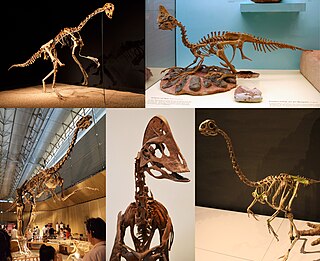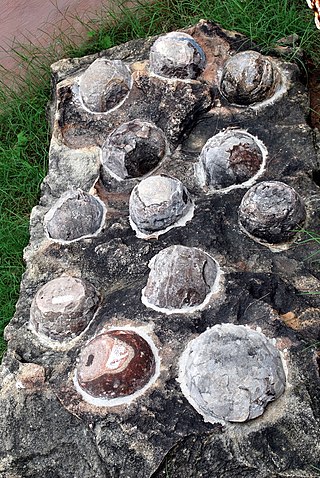
Stenonychosaurus is a genus of troodontid dinosaur from the Late Cretaceous Dinosaur Park Formation of Alberta, Canada, as well as possibly the Two Medicine Formation. The type and only species, S. inequalis, was named by Charles Mortram Sternberg in 1932, based on a foot, fragments of a hand, and some caudal vertebrae from the Late Cretaceous of Alberta. S. inequalis was reassigned in 1987 by Phil Currie to the genus Troodon, which was reverted by the recognition of Stenonychosaurus as a separate genus from the possibly dubious Troodon in 2017 by Evans et al. and also later in the same year by Van der Reest and Currie.

Oviraptorosaurs are a group of feathered maniraptoran dinosaurs from the Cretaceous Period of what are now Asia and North America. They are distinct for their characteristically short, beaked, parrot-like skulls, with or without bony crests atop the head. They ranged in size from Caudipteryx, which was the size of a turkey, to the 8-meter-long, 1.4-ton Gigantoraptor. The group is close to the ancestry of birds. Some researchers such as Maryanska et al (2002) and Osmólska et al. (2004) have proposed that they may represent primitive flightless birds. The most complete oviraptorosaur specimens have been found in Asia. The North American oviraptorosaur record is sparse.

Maiasaura is a large herbivorous saurolophine hadrosaurid ("duck-billed") dinosaur genus that lived in the area currently covered by the state of Montana and the province of Alberta, Canada, in the Upper Cretaceous Period, about 76.7 million years ago. Maiasaura peeblesorum is the state fossil of Montana.
Kenneth Carpenter is a paleontologist. He is the former director of the USU Eastern Prehistoric Museum and author or co-author of books on dinosaurs and Mesozoic life. His main research interests are armored dinosaurs, as well as the Early Cretaceous dinosaurs from the Cedar Mountain Formation in eastern Utah.
Preprismatoolithus is a Late Jurassic oogenus. The species P. coloradensis is described by John Foster as being "of the prismatic basic type," with subspherical eggs about 10 cm (4 inches) in diameter. This oospecies has been initially attributed to "hypsilophodontid" dinosaurs, although a lack of associated embryo material currently makes confirming the egg-layer's identity impossible, but now is known to be theropod after the finding in Portugal, associated with the embryos.

Dendroolithus is an oogenus of Dendroolithid dinosaur egg found in the late Cenomanian Chichengshan Formation, in the Gong-An-Zhai and Santonian Majiacun Formations of China and the Maastrichtian Nemegt and Campanian Barun Goyot Formation of Mongolia. They can be up to 162 mm long and 130 mm wide. These eggs may have been laid by a Therizinosaur, Sauropod, or Ornithopod. The oospecies "D." shangtangensis was originally classified as Dendroolithus, however, it has since been moved to its own distinct oogenus, Similifaveoloolithus. This oogenus is related with embryos of the theropod Torvosaurus

Youngoolithus is an oogenus of dinosaur egg. It is the sole member of the oofamily Youngoolithidae, and consists of a single oospecies: Youngoolithus xiaguanensis. It consists of a single fossil nest of 16 eggs with an associated dinosaur footprint that was first discovered in 1975 in the Majiacun Formation near Houzhuang Village, Henan Province, in the Cretaceous Xiaguan Basin. The eggs are smooth, olive-shaped, and arranged in five rows. It was originally described as being a Faveoloolithid egg, however the nest is arranged quite differently than other members of that family, so it has been moved to its own oofamily, Youngoolithidae.

Faveoolithus is an oogenus of dinosaur egg. The oogenus contains two oospecies, F. ningxiaensis and F. zhangi.

Megaloolithus is an oogenus of dinosaur egg. Some eggs belonging to this oogenus may have been laid by the titanosaur Hypselosaurus. They are known for having thick eggshells, at least 1.5 millimetres (0.059 in) thick, and the nearly spherical shape of the eggs. They are primarily found in India and Europe, but some specimens have been found in South America.
Sphaerovum is an oogenus of dinosaur egg that has only been discovered in South America.

Ovaloolithus is an oogenus of dinosaur egg. Eggs of the genus have been found in China, Mongolia and Utah.
Shixingoolithus is an oogenus of dinosaur egg from the Cretaceous of Nanxiong, China.

Spheroolithus is an oogenus of dinosaur egg.
Protoceratopsidovum is an oogenus of dinosaur egg from Mongolia. Despite its name, it does not represent the eggs of a protoceratopsid, but rather the eggs of maniraptoran theropods.
Ellipsoolithus is an oogenus of dinosaur egg. It contains only a single oospecies, E. khedaensis. The species was found in the Upper Sandy Carbonate Member of the Lameta Formation of India. These eggs were probably laid by a theropod dinosaur.
Oblongoolithus is an oogenus of dinosaur eggs, from the Campanian Barun Goyot Formation of Mongolia. The oogenus contains one oospecies O. glaber.
Subtiliolithus is an oogenus of fossil egg from the Nemegt Formation of Mongolia and the Ohyamashimo Formation of Japan. The eggs are notable for a very thin eggshell. It contains three oospecies: S. hyogoensis, S. kachchhensis and S. microtuberculatus. They were originally classified as a distinct oofamily, Subtiliolithidae, but numerous similarities to Laevisoolithus have led to their reclassification as Laevisoolithid eggs. A complete skeleton of Nanantius valifanovi was found associated with Subtiliolithus eggshells, indicating that the oogenus represents eggs of enantiornithine birds.

Egg fossils are the fossilized remains of eggs laid by ancient animals. As evidence of the physiological processes of an animal, egg fossils are considered a type of trace fossil. Under rare circumstances a fossil egg may preserve the remains of the once-developing embryo inside, in which case it also contains body fossils. A wide variety of different animal groups laid eggs that are now preserved in the fossil record beginning in the Paleozoic. Examples include invertebrates like ammonoids as well as vertebrates like fishes, possible amphibians, and reptiles. The latter group includes the many dinosaur eggs that have been recovered from Mesozoic strata. Since the organism responsible for laying any given egg fossil is frequently unknown, scientists classify eggs using a parallel system of taxonomy separate from but modeled after the Linnaean system. This "parataxonomy" is called veterovata.

Elongatoolithidae is an oofamily of fossil eggs, representing the eggs of oviraptorosaurs. They are known for their highly elongated shape. Elongatoolithids have been found in Europe, Asia, and both North and South America.
The Dushihin Formation is an Early Cretaceous (Aptian) geologic formation in the Övörkhangai Province of Mongolia. The formation preserves fossils of Psittacosaurus mongoliensis and fossil eggs described as Trachoolithus faticanus.










